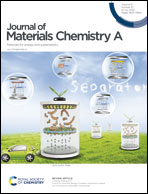A dog nose-inspired high-performance NH3 gas sensor of biomass carbon materials with a pleated structure derived from rose tea†
Abstract
Inspired by the similarity between the pleated structure of rose petals and the pleated structure of a dog's maxillary turbinate, porous biomass carbon materials with a pleated structure have been successfully prepared from rose petals by direct carbonization. Detailed SEM and TEM characterization showed that the carbonized rose tea (CRT) at 600 °C exhibited a mimetic structure very similar to the dog's maxillary turbinate. The trace K element was detected in the prepared CRT materials, which effectively improved the adsorption capacity of the CRT materials for NH3 as revealed by density functional theory based on first-principles calculations. As a result, the CRT sensor showed an ultra-high response (60.16k%) to 500 ppm NH3 with a theoretical detection limit of only 4.82 ppb, in addition to showing a fast recovery (2.0 s), excellent repeatability and long-term stability. Moreover, the formation of nanopores in the pleated structure of the CRT and the sensing mechanism of NH3 were analyzed. Through a simple, inexpensive and efficient method, this study provides a new strategy for the preparation of a high-performance gas sensor with a bionic structure by directly using the similarity between the biomass structure and dog nose structure.



 Please wait while we load your content...
Please wait while we load your content...